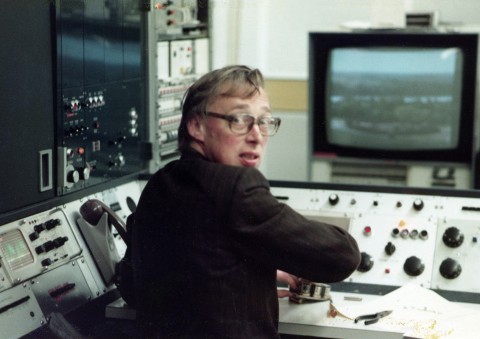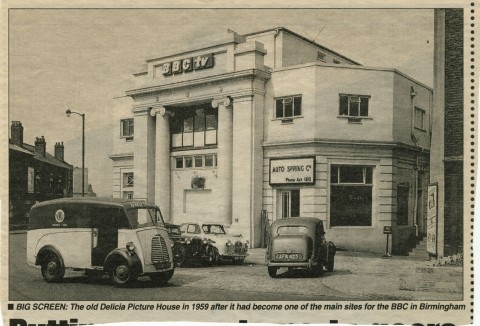
Photograph by Paul Scholes, no reproduction without permission.
The photo is of Paul Richards, TK operator (now deceased). It was probably taken in TK A.
TK, stood for Telecine, it was the area in post production that allowed for footage shot on film to be viewed on video equipment.
The following comments were left on the Pebble Mill Facebook Group:
Stuart Gandy: ‘TK was the second department I rotated into as a TA back in 1980. I was at first astonished at the sheer speed that Paul Taylor and Jim Gregory could lace up the machine. But they had to be able to. When TK was used for Midlands Today, it was quite common for the news film to arrive sometimes only seconds before on air time. Many times I can remember Milton Hainsworth rushing around to TK with the reel ready for lacing. In those days the filmed stories were edited into a continuous piece of film.’
Pete Simpkin: ‘One of the great tragedies of the use of film on regional news,especially in the 50s and 60s is that the original negative film was processed,edited and transmitted from TK which means that after only a few showings there was no way of getting a good quality archive copy which is why news clips from that era are of such poor quality. Shame after all the frantic and skilled work which was expended on getting newsfilm ‘on air’.’
Peter Greenhalgh: ‘I spent a few months in TK with Paul, Jim, Gregory, Dave Scholden, and John Duckmanton when I was a trainee about the same time as Stuart (1981). I remember it being a close, friendly team, and Paul gave me lots of good advice. I wasn’t allowed vinegar on my chips in the canteen though… I too remember how fast those guys were. The Sondor bay got me every time. If you forgot to move the top arm out of the way, when you got halfway though lacing it, it would rip the sepmag out of your hand and spool it back onto the reel!’
Peter Poole: ‘I didn’t know negative film was used for news. How was audio recorded? I remember reversal film being used in the 1970s. The quality of commag audio was poor. The TV farming programme was also shoot on reversal film due to its topical content. I often worked on the live TX from Studio B on Sunday mornings. Back then TK and VT needed a 10 second run up. The directors and PAs needed to run TK and VTs on time. If not the presenter would have to ad-lib to fill the gap. No wonder programmes from that time look rather slow.’
Pete Simpkin: ‘The negative film was used in the black and white period of the 50s, when regional TV news was started, and into the 60s up to the point when colour was introduced using as you say reversal film system. Black and white film used commag stock for sound, recorded in the camera and, this was often cut under pressure and any voice over links added usually live. Later there was a system called SEPMAG which, when the original camera audio had been copied across to the separate reel of film, enabled independent editing of pictures and sound and hence the introduction of dubbing suites. Unfortunately for news purposes it wasn’t always possible to re-unite the audio and picture onto commag so the separate reel had to be ‘locked’ or synchronised with the picture projector….a very hazardous and hair raising experience not only for the operators in TK but the studio director who would be often waiting for the ‘all clear’ that the locking up had worked !!’



